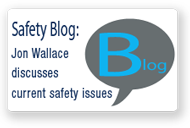“I learned a great deal that I will be able to apply... Thanks for a very informative, effective training session (30-Hour Complying with OSHA).” 

Join our Mailing List: |
Safety ArticlesOSHA Enforcement ToolsBy W. Jon Wallace, CSP, MBA Some employers assume OSHA compliance is achieved merely by compliance with the applicable OSHA code of federal regulations (e.g. 1910 General Industry, 1915 Maritime, 1926 Construction, 1928 Agriculture). However, this does not necessarily ensure full OSHA compliance. Employers must also be familiar with other OSHA enforcement tools such as Incorporation by Reference; the General Duty Clause; Letters of Interpretation; Standard Interpretations (STD’s); and Compliance Directives (CPL’s). To help assist you with the maze of OSHA compliance, listed below is an explanation of each of these OSHA enforcement tools. Incorporation by Reference is defined in 29 CFR 1910.6(a)(1) of the OSHA General Industry standards. OSHA lists government standards as well as consensus organization standards (e.g. ANSI, ASME, API, ASTM, CGA, NFPA, and SAE) which are incorporated by reference. These publications have the same force and effect as other OSHA standards. One example is the ASME Code for Pressure Vessels, 1968 Edition. It is important to understand, however, only the mandatory provisions (i.e. provisions containing the word "shall" or other mandatory language) within these standards are enforceable by OSHA. The General Duty Clause is listed under Section (5)(a) of the OSH Act: "Each employer –
The General Duty Clause is used to cite an employer when a specific OSHA standard does not exist. Examples: heat stress, workplace violence, and ergonomics. Publications are documents published by OSHA that have not gone through the OSHA rulemaking process. In some cases, OSHA will issue a publication, such as Ergonomics Program Management Guidelines for Meatpacking Plants and Guidelines for Preventing Workplace Violence for Health Care and Social Workers. Publications are not enforceable as OSHA standards but in some cases may be used in conjunction with the General Duty Clause to cite an employer for an unsafe work practice. Letters of Interpretation are written responses to employers who write OSHA requesting an interpretation on a specific OSHA standard. These interpretations are available on the OSHA Web Site. Although a letter of interpretation is not enforceable, it does provide guidance on OSHA’s perspective on a specific OSHA standard. An example is the "Permissibility of a Consent form with a waiver of liability" interpretation (July 22, 1993 – Anne Sturtz). The Bloodborne Pathogen standard [29 CFR 1910.1030(f)(1)(ii)(A)] requires the hepatitis B vaccine be made available at no cost to all employees who have occupational exposure to bloodborne pathogens. This letter of interpretation states it is not acceptable for employers to require employees to sign a waiver of liability in order to receive the hepatitis B vaccine. OSHA feels requiring an employee to sign a waiver of liability waives future rights for the employee and therefore is a cost to the employee. The entire letter of interpretation may be viewed on the OSHA Web site. Standard Interpretations (STD’s) are issued by OSHA to amend, change, or interpret an OSHA standard. Unlike Letters of Interpretation, an STD is legally enforceable. For instance, 29 CFR 1910.23(e)(1) requires the top rail of a standard rail (guardrail) to be 42" in height. Are you in violation of this requirement if your top rail is only 39" high? No. STD 1-1.10 permits top rail height to be between 36’’– 44’’ in height. Compliance Directives (CPL’s) provide instruction to an OSHA Compliance Officer on conducting inspections on a specific OSHA standard. Comparing an existing safe work practice against an applicable OSHA CPL is a valuable tool in assessing OSHA compliance. CPL 2 – 2.53 addresses first aid training programs. As you can see, the OSHA regulations are only one facet of ensuring OSHA compliance. As a matter of fact, if you were to place all of these documents on top of each other, the stack would be well over 6 feet high! It must be stressed that OSHA standards should be considered a minimal set of guidelines and don’t necessarily ensure employee safety. In some cases, specific safe work practices as well as "state of the art" industry safe work practices must be implemented to ensure employee safety.
If you have any questions concerning this article or other safety issues, please contact W. Jon Wallace, "The Safety Guru", at 919.933.5548 or by |
|||||||